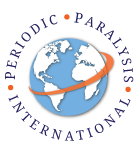Emergency Care for an Attack of Andersen-Tawil Syndrome
Submitted by deb on Fri, 08/12/2011 – 19:51
First Actions:
- Respiratory and cardiac arrest are possible.
- Call for Cardiac Monitoring/EKG
- Draw electrolytes to determine serum K+
- Provide 02 as thimble may not reflect 02 saturation due to cardiac dilitation
- Lie patient in coma position to avoid aspiration.

Monitor closely, weakness can rapidly progress to paralysis, torsades de pointes, cardiac arrest and respiratory failure. Paralyzed patients may appear to be unconscious, but are awake and aware. Do not assume they cannot feel pain or hear conversations.
Andersen-Tawil syndrome (ATS) is characterized by the triad of episodic flaccid muscle weakness, distinctive dysmorphic features, ventricular arrhythmias and prolonged QT interval. Patients with ATS may present to the ER with an attack of muscle weakness or flaccid paralysis and/or cardiac rhythm disturbances or prolonged QT interval (over 0.39 sec for men and 0.44 sec for women).
Less commonly patients experience syncope, cardiac arrest, or sudden death. While the ECG may reveal a long QTc interval (LQT), characteristic T-U patterns including enlarged U waves, a wide T-U junction, and prolonged terminal T-wave downslope distinguish ATS from other LQT syndromes. The ATS patient’s serum K+ can vary from attack to attack. Some patients are always normokalemic during attacks, some are hyperkalemic, most seem to be hypokalemic or have symptoms consistent with hypokalemia.
If serum potassium concentration is low (<3.0 mmol/L), administration of oral potassium (20-30 mEq/L) every 15-30 minutes until the serum concentration normalizes; if serum potassium concentration is high, ingesting carbohydrates (i.e glucose gel or tabs) may shorten the attack.
Monitor serum K+ and cardiac signs until strength returns and serum K+ is at patient’s optimum baseline.
Avoid medications known to prolong QT intervals; salbutamol inhalers; thiazide and other potassium-wasting diuretics. List of drugs to be avoided by patients with ATS;
References:
Tawil, R; Venance, S; Andersen-Tawil Syndrome. GeneReviews [Internet].
Pagon RA, Bird TD, Dolan CR, et al., editors. Seattle (WA): University of Washington, Seattle; 1993-.
Kirchhof P; Franz M; Bardai M; Wilde A. Giant T–U Waves Precede Torsades de Pointes in Long QT Syndrome: A Systematic Electrocardiographic Analysis in Patients With Acquired and Congenital QT Prolongation. J Am College Cardiology; Vol 54, Issue 2, 7 July 2009, Pages 143-149 [PubMed]
Andelfinger G, Tapper AR, Welch RC, et al; KCNJ2 mutation results in Andersen syndrome with sex-specific cardiac and skeletal muscle phenotypes. Am J Hum Genet. 2002;71:663–8. [PubMed]
Tristani-Firouzi M, Jensen JL, Donaldson MR, et al; Functional and clinical characterization of KCNJ2 mutations associated with LQT7 (Andersen syndrome). J Clin Invest. 2002;110:381–8. [PubMed]
Zhang L, Benson DW, Tristani-Firouzi M, at al; Electrocardiographic features in Andersen-Tawil syndrome patients with KCNJ2 mutations: characteristic T-U-wave patterns predict the KCNJ2 genotype. Circulation. 2005;111:2720–6. [PubMed]
